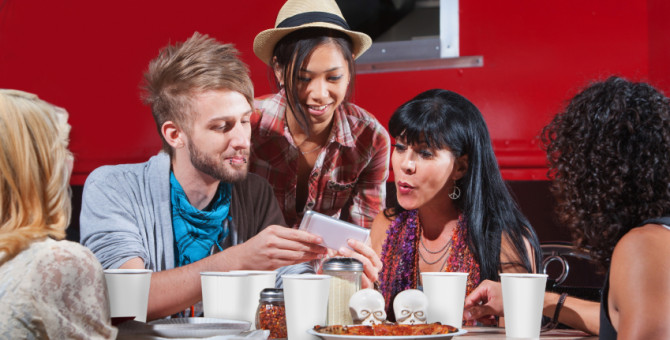When was the last time you were at a restaurant or public gathering and a good percentage of the people around you did NOT have their heads buried in a gadget? You have probably seen the video of the woman texting while walking, directly into a mall water fountain. We are a nation of tech addicts, continually connecting and browsing and searching. We expect instant results and for things to keep moving, and although there may be a general and ongoing conversation vocalizing concerns about privacy, online retailers like Amazon have proven that when data is used wisely to bring consumers and their objects of desire together quickly, the cash register rings.
What has changed significantly over the past few years is HOW we are consuming online; a 2012 Pew Research Center’s Internet and American Life Project report shows that three-quarters of America’s smartphone owners use their devices to retrieve information related to their location. We have learned to let our phone find us what we may want based on our location.
In a QSR context the the opportunity to provide offers and prompts correlated to the data you have gleaned from a loyalty program can be a game changer. Consumers have proven that they’re willing to share personal data in return for loyalty program rewards, and in doing so give you insights you can leverage because of smartphones, and location-based services.
Quick Service Restaurants have awakened to the possibilities via mobile loyalty, and many are already exploring the possibilities regarding what data should be captured as well as what actionable insights to pay attention to.
Data Matters
According to an Aberdeen report, companies that centralize and operationalize customer data have 3.5x higher retention rates, achieve 20% year-over-year customer lifetime value growth, and 90% greater year-over-year annual company revenues. What that means in plain English is that QSRs who collect and understand data their customers willingly provide are able to sell more, and early loyalty from their customers.
With a mobile loyalty program you can encourage people to give you more information about themselves by doing specific promotions, i.e. tell us more about yourself, get a free drink. You can learn the age, gender, location… the information you need to craft the type of promotion to pull that existing customer back into your QSR.
By collecting this data, not only can you prompt a consumer to come and buy from you, you can provide your company with valuable information to be used company wide for far more than marketing.
What data are you capturing right now about your customers? Does the ability to correlate offers with a lift in sales revenue remain elusive? Is ROI something you still struggle to prove or can claim with pride? How automated are your data capturing efforts and what are your objectives?
As business owners, we want to know such things as:
• How many customers we have
• The proportion of customers that constitute the majority of revenue (is it the 80:20 rule)
• Customer churn
• Frequency of purchases
• Average purchase amount
• What was purchased
• Timing of purchases
• Purchase drivers (offers or other factors)
• Lifetime value
• Their online and offline behaviour
Where is the Privacy Line?
Consumers are willing to share information passively or proactively in exchange for something of value, but stopping short of being creeped out. That’s what Amazon has figured out – how to use data to provide prompts in a way that consumers appreciate, versus Facebooks sometime random ads that are so off base they get consumers questioning why on earth they’re there… and wondering what Facebook thinks it knows about them.
Businesses doing it right provide prompts that the customer wants, and are using customer experience as a competitive differentiator. Southwest Airlines uses speech analytics to analyze live-recorded interactions between customers and staff to get a better understanding of their customers and their needs, thus helping both the airline AND the passenger.
What kind of data are you gathering about your customers? How are you capturing it? What else are you looking to capture? Where are you finding challenges or obstacles related to customer data capture?
You may know perfectly well what data you want to capture about a customer, but how do you do it? While technology can be helpful, it can also present hurdles that can require time and investment to overcome. In a thin margin business, priorities and trade-offs have to be considered.
Ideally, you and your customer want simplicity. You want simple transmission of data to and from customers. You want it to be easy to recognize customers instore and reward them based on location. You want the confidence that your loyalty system is secure and that you can extend that promise of security to your customers. Furthermore, you want the exchange between you and customers to be as frictionless as possible with little to no technical support requirements related to onboarding and participation in your loyalty program.
Is your approach to loyalty simple? Is it close to frictionless? What is onboarding like for customers or franchises? If the answers to any of those questions are less than ideal then perhaps we should be chatting. We can share recent client experiences like Currito’s and explain where we can help you close the customer data gap while building a robust yet simple to implement mobile loyalty program.

